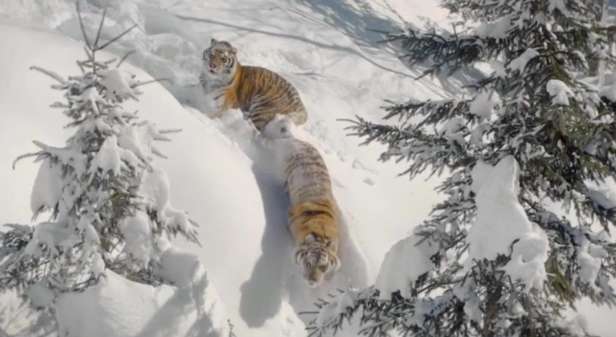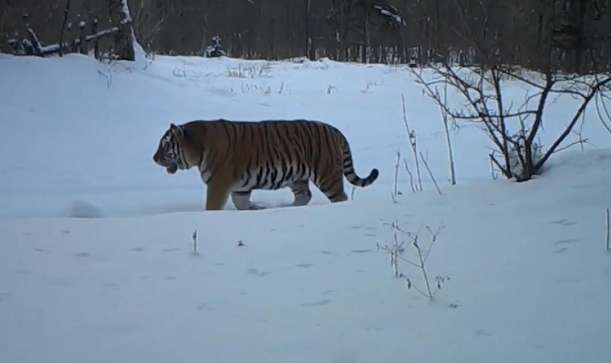The number of tigers in our country is rare, but there are many species. There are still 4 species of tigers, namely the South China tiger, the Siberian tiger, the Indochinese tiger and the Bengal tiger. Among them, the South China tiger is the only type of tiger that exists in our country. It is now extinct in the wild and only survives in zoos.
The Siberian tiger is the largest type of tiger in existence and the most important wild tiger species in my country. It is the most cold-resistant among modern tigers and its habitat is in northeastern Asia. In 2017, there were only 27 wild Siberian tigers in my country. Thanks to the construction of the ecological environment and the effectiveness of animal protection work, their number has now increased to more than 60.

The Siberian tiger's scientific name is the Siberian tiger, but did you know? In fact, the name "Siberian tiger" does not suit them. Judging from the name, it seems that they are a specialty of Siberia and are widely distributed in Western Siberia. But in fact, the distribution of Siberian tigers in Siberia is very limited, limited to the southeastern corner.
There has been no tiger in the vast interior of Siberia since ancient times. As we all know, the tiger is a cat with remarkable exploratory behavior and high mobility. Why did the tiger fail to conquer the Siberian interior when the species was at its peak? Is there anything there that could scare a tiger?
Distribution of Siberian tigers
Modern tigers originated in East Asia 3 million years ago. They migrated and spread several times before reaching other parts of Asia. After a long period of geographical isolation, Eventually, 9 subspecies were formed.
The migration of modern tigers can be roughly divided into two general directions: one is along the south and southeast into the Indian subcontinent and Southeast Asia; the other is toward the northwest of my country and into western Asia, but it fails to cross. Enter Europe.
In addition to the two general directions, modern tigers also spread in many directions at the same time, but in the end they did not enter the interior of Siberia. This means that at the peak of the modern tiger family, they did not conquer the vast Siberian interior.

Historically, Siberian tigers have experienced two large-scale migration waves. However, during these two migration waves, they did not set foot in the interior of Siberia.
After the end of the 19th century, Russia took the lead in killing tigers in large numbers, resulting in a sharp decline in the number of Siberian tigers. At that time, in addition to the hunted tigers in Russia, many tigers fled to China along ecological corridors for refuge.< /p>
In the second half of the 20th century, China also began to hunt tigers on a large scale, and some Siberian tigers fled to Russia along ecological corridors. This is one of the main reasons why Russian tigers are growing so fast. Since these two times Judging from the migration wave of Siberian tigers, it seems that they have never thought of running to the interior of Siberia.
There are plenty of prey in the interior of Siberia
Why does this happen? Many People's first reaction is that there is a lack of prey in the interior of Siberia, or a lack of prey resources, which makes the Siberian tiger reluctant to settle. This view has a certain basis. The abundance and distribution range of prey have greater significance for predators. Strong impact.
For example, the Canadian lynx is seriously affected by the distribution of the white-shoe hare, as well as the Asiatic lion. When the indigenous Malhari people did not move out of the protected area, 75% of their prey sources were They are all livestock, and after the Malhari people moved out of the reserve, this proportion dropped to 25%.

So the Siberian tiger does not want to go to the interior of Siberia, is it because of prey?
The Siberian tiger likes to hunt. Large prey. An ecological study based on the eastern mountains of Sikhote found that large ungulates are the main prey of tigers. Among them, red deer, wild boar, and roe deer have a great impact on them. They are the three favorite preys of Siberian tigers. Animals.
Although the inland areas of Siberia are severely cold, there are many wild boar populations and various deer species. Moreover, due to the severe cold climate, the food here is not easy to perish, and faces low "cleanliness" "Dolf" pressure, capturing an adult large wild boar is enough to eat for a long time. To be honest, there is no shortage of Siberian tiger prey in the Siberian interior.
Environment affects species survival
Excluding the scarcity of prey, some netizens believe that large brown bears exist in the interior of Siberia, which may be a threat to Siberian tigers, so they have not set foot there since ancient times.
In fact, this assumption is even more nonsense, because in the current habitat of Siberian tigers,There are Ussuri giant brown bears, but no research has ever found that their presence can have a big impact on the survival of Siberian tigers.
On the contrary, every autumn and winter is the peak period for Siberian tigers to hunt bears. Tigers in this season have more aggressive hunting strategies and will hunt bears to beat their teeth as sacrifices.
Scientists once investigated the diet structure of Siberian tigers in the Sikhote-Alin area and found that bears accounted for 7.1% of their food sources, of which 1% were Ussuri brown bears.
As the saying goes "survival of the fittest, survival of the fittest", the impact of the environment on species is not only reflected in direct competition for survival, but also has a profound impact on them from various angles.
Take African lions as an example. Lions live in the Serengeti savanna. Because there are a large number of ungulates here, their mouths are very picky and they basically only hunt fat ungulates. , they have no regard for porcupines, which are prey with few meat and thorns and are difficult to catch.
For some lions living in arid areas, such as the lions in the Namib Desert, having porcupines to eat is already a luxury.
Although Siberian tigers are the northernmost tiger, their thick fat and thick hair make them very cold-resistant. However, the inland areas of Siberia have long winters and are covered with snow all year round, and the snow is very deep, which is obviously not conducive to Siberian tiger hunting.
In order to adapt to hunting on snow, the Canadian lynx has undergone specific changes in its body during the long process of species evolution. The soles of its feet have become very wide, which has caused them to lose a lot of combat effectiveness, so even small animals Even small fishermen can kill it. Fortunately, hunting white-shoe rabbits does not require any combat power, just being fast enough.
This kind of thing is not possible for the Siberian tiger. If it is like the Canadian lynx, its body is specialized in order to survive in the interior of Siberia, let alone whether it can withstand wolves. and big brown bears, even hunting larger wild boars is a problem.
For Siberian tigers, the interior of Siberia is not a good choice no matter in ancient or modern times, so they will naturally not choose to conquer there.
Nowadays, the number of Siberian tigers in Russia has approached the saturation level of the environment. On the one hand, it is the Siberian interior that is not suitable for survival, and on the other hand, it is the forest, sea and snowfields of our country that are their hometown. Know how to choose.
In fact, the third migration of Siberian tigers has quietly begun, migrating from Russia to our country. In recent years, Russian tigers have continued to come to our country through the four ecological corridors that have been discovered.